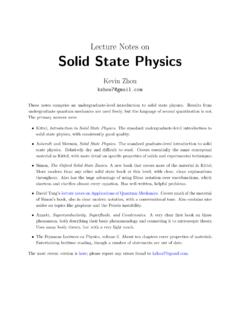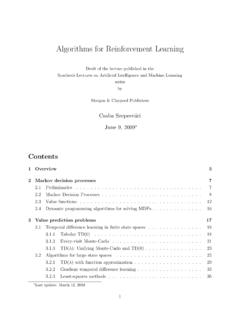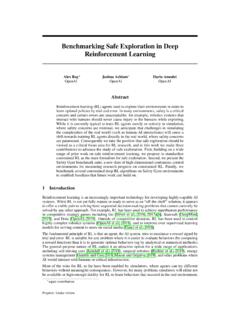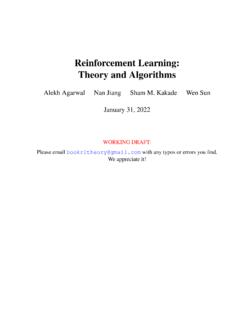Transcription of Lecture Notes on Machine Learning - Kevin Zhou
1 Lecture Notes onMachine LearningKevin Notes follow Stanford s CS 229 Machine Learning course, as offered in Summer 2020. Othergood resources for this material include: Hastie, Tibshirani, and Friedman,The Elements of Statistical Learning . Bishop,Pattern Recognition and Machine Learning . Wasserman,All of Statistics. Russell and Norvig,Artificial Intelligence: A Modern Approach. Mackay,Information Theory, Inference, and Learning Algorithms. Michael Nielsen s online book,Neural Networks and Deep Learning . Jared Kaplans s Contemporary Machine Learning for Physicists Lecture Notes . A High-Bias, Low-Variance Introduction to Machine Learning for most recent version is here; please report any errors found to Supervised Introduction.
2 Linear Regression .. Logistic Regression .. Generalized Linear Models .. Kernels .. 122 More Supervised Generative Learning .. Neural Networks .. Support Vector Machines .. Bayesian Methods .. 253 General Bias-Variance Tradeoff .. Practical Advice .. Evaluation Metrics .. PAC Learning .. 344 reinforcement Markov Decision Processes .. Policy Gradient .. 405 Unsupervised Clustering .. Expectation Maximization .. Principal and Independent Component Analysis .. 4631. Supervised Learning1 Supervised begin with an overview of the subfields of Machine Learning (ML).
3 According to Arthur Samuel, ML is the field of study that gives computers the ability to learnwithout being explicitly programmed. This gives ML systems the potential to outperform theprogrammers that made them. More formally, ML algorithms learn from experiences by usingthem to increase a performance measure on some task. Broadly speaking, ML can be broken into three categories: supervised Learning , unsupervisedlearning, and reinforcement Learning . Supervised Learning problems are characterized by having a training set that has correct labels. Simple examples include regression, fitting a curve to points, and Learning has its roots in statistics.
4 Generically, a supervised Learning algorithm will minimize some cost function over a hypothesisclassHevaluated on the training set. This will give a model that can be used to predict labelson a testing set . Choosing the minimization procedure itself constitutes an entire field ofstudy, optimization . We ll mostly avoid the details of it here. Picking a goodHis called the model selection problem. If it s too simple, it may underfitting,being not be powerful enough to capture the trust; if it s too complicated, it may overfit to thetraining set, and do badly on the testing set. This is called the bias-variance tradeoff.
5 In unsupervised Learning , the goal is instead to find structure in an unlabeled data set. A typicalexample is clustering, finding news articles about the same topic, or groups in a socialnetwork. Other examples include dimensionality reduction, (probability) density estimation,and outlier/anomaly detection. There are also semi-supervised Learning algorithms, which doclassification when only some of the examples are labeled, and weakly supervised algorithms,which can cope with noisy labels. In reinforcement Learning (RL), we think in terms of an agent which moves between states in an environment , seeking to maximize a reward signal by Learning an appropriate policy ,without being explicitly told how.
6 Most popular depictions of ML focus on RL, which has itsroots in control theory from engineering. It also has roots in biology, with similar language usedto describe animal Learning . Examples include Learning to play a board game, or maneuveringa robot past obstacles. Often, RL systems model and predict their environment, and may use supervised or unsupervisedlearning algorithms as subroutines. However, the overall problem is more general, and morerealistic. Also, model-free RL systems exist, such as genetic algorithms or simulated annealing. One of the fundamental problems of RL is the explore-exploit tradeoff, whether the agentshould keep on doing the same thing to get a known reward, or try new things for the potentialof an even higher reward.
7 We can describe this tradeoff formally by having the agent maximizea value function , which accounts for both the reward itself, and the possible rewards it couldget by further Supervised Learning As an example, if an agent plays tic tac toe against a fixed opponent, it s easy to find a way toguarantee a tie. But if the opponent is imperfect, there could be a different sequence of movesthat could force a win. If the agent explores sufficiently, it can find this , we fix notational conventions. Given a functionf:Rm n R, the gradient offwith respect toAis them nmatrix ofpartial derivatives( Af(A))ij= f includes the gradient with respect to a vector as a special case.
8 As examples of vector gradients, we have x(bTx) =b, x(xTAx) = (A+AT) that in the second expression we can takeAto be symmetric without loss of generality,since it doesn t change the left-hand side. We ll drop the subscript when it s clear what thegradient is with respect to, and we distinguish vectors and matrices by context. As basic examples of matrix gradients, we have A(trAB) =BT, ATf(A) = ( Af(A))T. A slightly trickier example is A(detA) = (detA)(A 1)Twhich is best shown using the component expression for the determinant. As a special case, forpositive definiteAwe can always define log detA, and A(log detA) =A 1where we used the fact thatAis symmetric.
9 Given a functionf:Rn R, the Hessian matrix with respect toxis the symmetricn nmatrix of second derivatives, which we write as( 2xf(x))ij= 2f(x) xi other words, when we write 2, we mean , not as in conventional in physics.(We could also take the second derivative with respect to a matrix, giving a rank 4 tensor.) Thefunctionfis convex if the Hessian is positive semidefinite (PSD). As a simple example, 2x(xTAx) =A+AT= 2 Awhere we assumedAwas Supervised a symmetric matrixA, consider the optimization problemmaxxTAxsuch thatxTx= ,xshould be aligned with the eigenvector ofAwith largest eigenvalue. To show thisformally, we form the LagrangianL(x, ) =xTAx (xTx 1)which then gives xL= 2Ax 2 x= 0which is precisely the condition thatxis an eigenvector a multivariate Gaussian random variable,x N( , ), we havep(x; , ) =1(2 )d/2| |1/2exp( 12(x )T 1(x ))where is ad-dimensional vector and is ad dPSD matrix.
10 Suppose we split these into blocks,x=(xAxB), =( A B), =( AA AB BA BB).The block form of 1is(VAAVABVBAVBB)=(( AA AB 1BB BA) 1 ( AA AB 1BB BA) 1 AB 1BB 1BB BA( AA AB 1BB BA) 1( BB BA 1AA AB) 1).The marginal and conditional distributions are also Gaussian,xA N( A, AA), xA|xB N( A+ AB 1BB(xB B), AA AB 1BB BA)along with the analogous expressions withAandBswapped. The first result just follows from thedefinitions of and AA, while the second can be shown by completing the the conditional distribution, the term added to the mean represents how knowledge ofxBshifts the distribution ofxA, which is why it is proportional to AB, while the term subtractedfrom the variance represents howxBreduces the uncertainty inxA.







